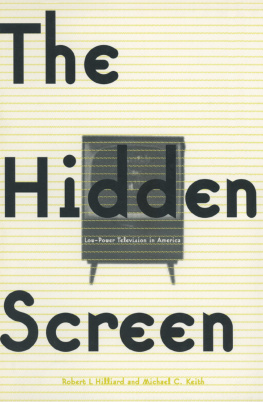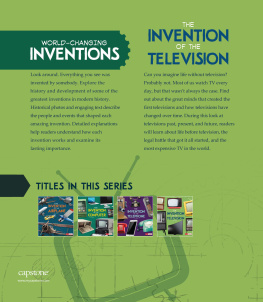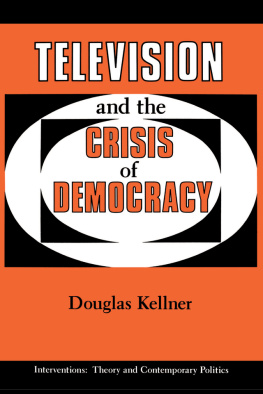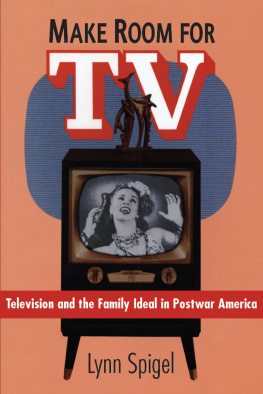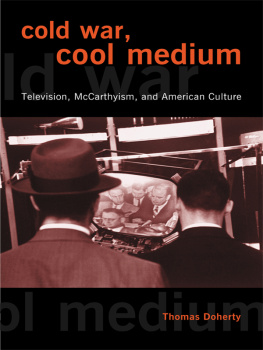The
HIDDEN
SCREEN
The
HIDDEN
SCREEN
Low-Power Television in America
Robert L.Hilliard and Michael C. Keith
First published 1999 by M.E. Sharpe
Published 2015 by Routledge
2 Park Square, Milton Park, Abingdon, Oxon OX14 4RN
711 Third Avenue, New York, NY 10017, USA
Routledge is an imprint of the Taylor & Francis Group, an informa business
Copyright 1999 Taylor & Francis. All rights reserved.
No part of this book may be reprinted or reproduced or utilised in any form or by any electronic, mechanical, or other means, now known or hereafter invented, including photocopying and recording, or in any information storage or retrieval system, without permission in writing from the publishers.
Notices
No responsibility is assumed by the publisher for any injury and/or damage to persons or property as a matter of products liability, negligence or otherwise, or from any use of operation of any methods, products, instructions or ideas contained in the material herein.
Practitioners and researchers must always rely on their own experience and knowledge in evaluating and using any information, methods, compounds, or experiments described herein. In using such information or methods they should be mindful of their own safety and the safety of others, including parties for whom they have a professional responsibility.
Product or corporate names may be trademarks or registered trademarks, and are used only for identification and explanation without intent to infringe.
Library of Congress Cataloging-in-Publication Data
Hilliard, Robert L.
The Hidden Screen: low-power television in America / Robert L. Hilliard and Michael C. Keith
p. cm.
Includes bibliographical references and index.
ISBN 0-7656-0419-1 (hardcover : alk. paper).ISBN 0-7656-0420-5 (pbk : alk. paper)
1. Low power television-United States. I. Keith, Michael C. II. Title.
HE8700.72.U6H55 1999
384.554dc21 98-44069
CIP
ISBN 13: 9780765604200 (pbk)
ISBN 13: 9780765604194 (hbk)
Contents
Frank H. Tyro
David A. Tucker
Mark Banks
Michael Havice
Over the years, as we tracked the count of broadcast media around the country for our various studies, we grew increasingly curious about a category of stations called LPTV. In Broadcasting and Cable magazines weekly tally of radio, television, and cable outlets, these rather cryptic initials (very few of those we queried knew what they represented oreven if they didwhere and what these stations broadcast) were always accompanied by a steadily rising figure600 800 1,300 1,800
The questions in our minds about this new medium grew as the numbers climbed. How could 2,000 television signals (the FCC has actually issued more low-power than full-power licenses), even if driven by minuscule wattage, escape the notice of those of us devoted to Fifth Estate research? There was very little scholarship published on LPTV, especially concerning its role as an electronic purveyor of information and entertainment. All in all it seemed to us that we were dealing with something almost clandestine or underground in naturesomething LPTVer Dave Pierce affectionately calls guerilla television in . This broadcast phenomenon we came to term the hidden screen, not because it was designed or intended to serve a surreptitious purpose but because of its stealthy, if not enigmatic, presence in the broadcast firmament.
As we began our inquiry into low-power television, it quickly became evident that this was a medium very much above ground and of this world. It was out there for all, or almost all, to see, and it could be found in nearly every part of the countryoften in places other mass media had ignored or forsaken. LPTVs also existed in signal-laden metropolitan areas. Our research uncovered many things, but foremost it revealed a determined and diverse group of stalwart broadcasters, whose goal it was (and is) to provide locally and demographically relevant television to viewers. This formidable objective was almost always attempted on a shoestring budget and often in conditions that were less than Spartan, to say the least.
The programming LPTV stations offer is, if anything, eclectic and often homespunqualities quite rare in mainstream, big-dollar television. Not all LPTV operations devote themselves to diverse, locally oriented shows, however. Many are content to transmit a potpourri of recycled and calcified reruns and aging B-movies for the sake of generating income, but happily this is not a dominant approach. Meanwhile, some vested-interest groups representing right- and left-wing political factions, religious organizations, and community groups employ LPTV signals to help realize their specific agendas.
Ultimately most low-power television broadcasters see themselves as providing a vital primary service for viewers despite their secondary categorization, which they hope will change with status upgrading by the Federal Communications Commission. Should the medium achieve its much-sought-after Class A standing, its broadcasters believe they will be in an enhanced position to fulfill its mandate and continue in the role of providing audiences with a valuable viewing option. (As this manuscript entered the final stage of its production in March 1999, the FCC appeared about to propose that low-power television stations be granted primary status.)
Time will tell whether the climate for LPTV broadcasters will improve or if they will lose their much-cherished frequencies in the metamorphosis to digital by the so-called big-guysthe full-power television operators. In the meantime, LPTV practitioners will continue to bring their unique vision to a medium that sometimes can be very myopic.
Many individuals contributed to this study and for this deserve appropriate recognition. Therefore we wish to thank, among others, Ken Carter (who gave one of your authors his first broadcast job), Mark Banks and Michael Havice (communications scholars and colleagues), Dave Pierce (ground-breaking bayou broadcaster), Frank Tyro (teacher of Native American future mass media practitioners), Robert Perry (lawyer and champion of First Amendment causes), Ed Shane (sage of the airwaves), and Sherwin Grossman and John Kompas (tireless advocates of the LPTV medium).
For their admirable efforts to enrich the airwaves, we salute LPTV broadcasters and dedicate this humble volume to the communicators who make it possible.
The
HIDDEN
SCREEN
LPTV Characteristics
Low-power television stations are regular broadcast stations that operate with greatly reduced power compared to that of full-power traditional television stations and that, consequently, reach a much smaller geographical area and a smaller number of viewers.
Low-power television stations or, as they are called, LPTV stations, were designed to provide additional television channels in communities that had available frequencies, but which were too close to other cities with co-frequencies (that is, the same frequency assignments) or adjacent frequencies, so that the addition of any more full-power television stations would interfere with other stations signals. Low-power stations in those communities, reaching perhaps from 5 to about 15 miles compared to 40 or 50 miles for full-power stations, are not as likely to create interference. This enables willing entrepreneurs to apply for permits to construct and operate stations where otherwise no additional TV services could be accommodated. Essentially, therefore, serving a limited geographical area, these LPTV stations orient their programming and advertising to a specialized, local audience.


